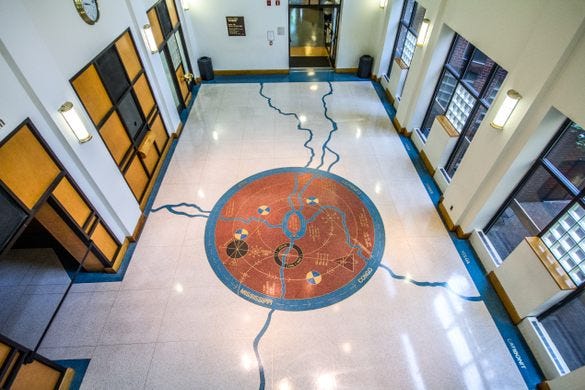"Daybreak in Alabama" and The Black American Dream
"I'm gonna write me some music about Daybreak in Alabama And I'm gonna put the purtiest songs in it"
I have never been a poetry girly. And I know, as someone who has studied American lit for too damn long, I should really have read more Langston Hughes than I have. Well excuse me for obsessing over novels that I’ll never finish!
I recently found out that Hughes’ resting place is beneath a beautiful mural in the Schomburg Center in Harlem which of course lead me to think back to the few poems I have read by him.
One of those poems is “Daybreak in Alabama”, the final poem in his book The Panther and The Lash. I remember really obsessing over this poem when I first read it all those years ago. I wont reprint it here out of fear of being sued into oblivion by Knopf but you can read it for free at the Poetry Foundation. I really recommend that you do.
My obsession with this poem is rooted in the beauty of its language. I love anything with purple prose, it really is my fatal flaw. However, Hughes’ description and inclusion of the beauty of Alabama and the black, brown, yellow, white, and “red clay” hands are what give this poem meaning for me.
Hughes writes of a song, one that encapsulates the beauty of Alabama for both her nature and her people. Hughes writes that the hands are “Touching everybody with kind fingers Touching each other natural as dew”. It becomes clear to the reader that he is writing about a future of kindness and unity between all races of people, but what sticks out to me is the art in the poem.
Hughes writes a poem about music written in images signifying unity between people who have both suffered and benefited from the consequences of white supremacy in their communities. The use of poetry to literally paint a picture of a better future (because it most certainly was not a song of the present or the past) reminds me of the escapism and hope that can be found in art such as Hughes’.
In 1918, during a stay in Chicago, Langston Hughes was brutally beaten for crossing through a Polish neighborhood on his way home. James Presley explains further in his essay “The American Dream of Langston Hughes”, “That night as he tended to his injuries young Hughes must have mused disturbed thoughts about fulfillment of his American dream of freedom, justice, and opportunity for all” (380).
Hughes himself writes in his 1926 essay “The Negro Artist and The Racial Mountain”
“Most of my own poems are racial in theme and treatment, derived from the life I know. In many of them I try to grasp and hold some of the meanings and rhythms of jazz. I am as sincere as I know how to be in these poems and yet after every reading I answer questions like these from my own people: Do you think Negroes should always write about Negroes? I wish you wouldn’t read some of your poems to white folks. How do you find anything interesting in a place like a cabaret? Why do you write about black people? You aren’t black. What makes you do so many jazz poems?”
Hughes is no stranger to the horrors of the color line, especially as a man who’s lineage is made up of multiple races: Native American, White, and Black. Like others during the early 20th century, Langston was not oblivious to the realities of being black.
Using art to escape the brutal realities of life is also nothing new or unique to Hughes, however, I stay amazed at the resilience of black people from our ability to survive the horrors of slavery to adapting through the racism that permeated through out America (not just the south) from reconstruction to present day. We stay bouncing back through art.
In “Daybreak in Alabama”, Hughes imagines a utopia where the realities of racism are a thing of the past. His very own American dream. There is peace between not only the people but also the people and the earth. The sun is shining, the flowers are blooming… Nature is healing, as the girls say.
The way that Hughes writes it, Daybreak in Alabama is the dawn of not only a new day but a new world, one that is kinder than our own. That is the beauty of our imaginations. This is what makes life worth living, the art that allows us to envision a better future.
When I read works like “Daybreak in Alabama”, I am reminded that the persistent horrors ain’t got nothing on the brilliance of black folk.
“But jazz to me is one of the inherent expressions of Negro life in America; the eternal tom-tom beating in the Negro soul—the tom-tom of revolt against weariness in a white world, a world of subway trains, and work, work, work; the tom-tom of joy and laughter, and pain swallowed in a smile.” (Hughes)
References
Hughes, Langston “The Negro Artist and The Racial Mountain.” The Nation. 1926. Black Past. https://www.blackpast.org/african-american-history/primary-documents-african-american-history/1926-langston-hughes-the-negro-artist-and-the-racial-mountain/. Accessed 1 Apr. 2024.
Presley, James. “The American Dream of Langston Hughes.” Southwest Review, vol. 48, no. 4, 1963, pp. 380–86. JSTOR, http://www.jstor.org/stable/43467552. Accessed 1 Apr. 2024.




